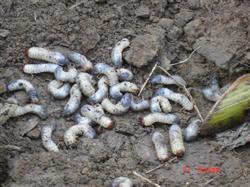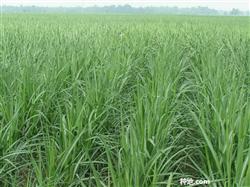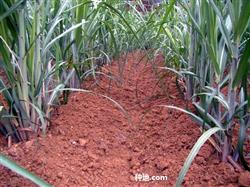How to control underground pests in sugarcane planting?

How does sugar cane cultivation control underground pests? Sugarcane underground pests are a serious harm to Yunnan sugarcane production of a class of important pests, mainly: sugarcane turtle, sugarcane head weevil, borer weevil, sugarcane termites, sugarcane root aphid, etc., among which sugarcane turtle, sugarcane head weevil, borer weevil occurrence is the most common, the most serious harm, the pests and control methods are as follows: sugarcane turtle 1. The main species are: (1) Large equal gill beetle (2) sugar cane beetle and light back beetle (2) occurrence and harm (1) large equal gill beetle: mostly distributed in fertile sandy loam zone, mainly larvae harm roots The insect has a large body and a large appetite. The harm period lasts for 6 months from early June to mid-November. It can eat up all the fibrous roots, leaving only one cane pile inserted in the soil. It will rise when it is carried and fall when the wind blows, causing the whole hill and whole piece to die. It is a destructive insect species. (2) Protruding back, light back sugar cane beetle: mostly distributed in gentle slope zone or alluvial sandy loam in river valley. From April to May, adults mainly bite the base of sugarcane seedlings, resulting in the death of withered cores, and the damage rate can reach more than 40%, resulting in lack of ponds and broken ridges. From September to March, larvae mainly feed on the underground part of sugarcane stems, and the sugarcane heads are eaten into caves, which seriously affect the growth of ratoon roots. 3. Control methods (1) agricultural control ① deep ploughing and sun-drying: in sugarcane fields where sugarcane turtles are seriously damaged and do not stay, sugarcane should be deeply ploughed and harrowed in time after harvest. Due to mechanical action and manual picking, overwintering mature larvae and some pupae can be effectively removed. (2) Flooding control method: large and equal gill beetle in July ~ August, protruding back, light back sugarcane beetle in October ~ November, sugarcane growth season, not afraid of flooding, and sugarcane turtle in the larval stage, conditional can be flooded with water irrigation sugarcane field, generally flooded ridge surface for about 7 days, can drown underground sugarcane turtle. ③ Sugarcane rice (paddy and drought) rotation: serious harm sugarcane land, can rotate rice, through long-term flooding, can eliminate the residual sugarcane turtle in the soil, can reduce the harm by about 80%. 4. Avoid the period of emergence of newly hatched larvae (May ~ June) and apply decayed organic fertilizer to create an unfavorable environment for the survival of newly hatched larvae, control the occurrence of sugarcane turtles, and reduce the harm. (2) Physical control. The strong phototaxis of the adults of the turtle was used to trap and kill the adults with Jiaduo frequency vibrating lamp during the peak period of adult emergence (April ~ May). (3) Biological control of large isobranchus beetle in late May and early June, combined with sugarcane cultivation; in early April, 2% Beauveria bassiana and Metarhizium anisopliae powder granules were selected for weeding sugarcane seedlings, mixed with dry fine soil 40 kg or chemical fertilizer, and evenly spread on the base of sugarcane plants. (4) Chemical control of isobranchus megalobellus at the end of May and the beginning of June, combined with sugarcane cultivation soil; in early April, when sugarcane seedlings are loose, 15% Losben granules 1~ 1.2kg, 3% carbofuran granules 4~ 5kg or 8% Jinxianxin granules 3~ 4kg are selected per mu, mixed with dry fine soil 40kg or chemical fertilizer, and evenly spread on the sugarcane plant base covering soil; At the end of October, 48% Lesben EC 300~400 ml, 90% monosultap EC 300 g, 50% phoxim EC 500 ml were selected for each mu. After dilution with water according to the dosage per mu, the sugarcane plant base was evenly watered. 1. The main species of sugarcane weevil are: ① thin flat weevil ② spotted weevil 2. Occurrence and damage are mostly distributed in the southwestern Yunnan sugarcane area along the river dam and some low wet sugarcane. Fine flat elephant: harm sugarcane head with larvae and adults, early hatching larvae bite into tender roots of sugarcane seedlings in the middle of April, eat upward, enter sugarcane head harm, harm period up to 8~10 months; spotted elephant: harm sugarcane head with larvae, harm period from June of the current year to February ~ April of the next year, the whole larva stage is in sugarcane head harm. From October to December, the sugarcane heads were seriously damaged, some of them were eaten into pieces, 5~6 insects were found in one sugarcane head, and more than 20~30 insects were found. After damage, 0.5~3 tons of sugarcane will be lost per mu, and serious harvest will not be achieved; the brix of sugarcane in the field will be reduced by 4%~6%, and the ratoon root can only be maintained for one year. In addition, the affected sugarcane head is susceptible to red rot, accelerated rot, easy lodging, and heavier losses. 3. Control methods (1) Agricultural control ① turning over and burning: If the sugarcane land with serious insect infestation does not stay at the root, it will be cut down in time before the middle of January and burned in the sun; it can kill a large number of overwintering adults or mature larvae, reduce the number of insects, and control its large-scale spread. ② Shorten the years of ratoon: sugarcane land with serious pests, leaving no ratoon for two years, so as to reduce the accumulation of elephant insect population in the field and reduce the damage rate. ③ Sugarcane rice rotation: Sugarcane and rice rotation, through long-term flooding can eliminate the residual insects in the soil, can greatly reduce the damage rate. ④ Remove sugarcane stumps in irrigation ditch: the sugarcane stumps dug out with insects shall not be piled up on the ridge of ditch and river, and the sugarcane stumps found in irrigation ditch shall be picked up at any time to avoid flowing water bringing the sugarcane stumps with insects into the insect-free sugarcane land. 5. Carefully remove the wild host plants of insects such as Cut-hand-density, Echinochloa arundinacea, Reed, Imperata alba, etc. on the ridge beside the field, and it is best not to rotate with corn. 6 sugarcane head weevil will not fly, introduced from the occurrence area, it is best to use half stem for seed, such as the use of whole stem for seed should be careful not to cut close to the soil surface, so as to avoid long-distance transmission of weevil with seedlings. (2) Biological control: 2% Beauveria bassiana and Metarhizium anisopliae powder 2~ 3kg/mu, mixed evenly with 40kg dry fine soil or chemical fertilizer, planting sugarcane in spring, sowing sugarcane evenly at the base of sugarcane plant and covering soil in time when loosening sugarcane in March ~ April or cultivating soil in May ~ June. (3) Chemical control: 1~1.2 kg of 15% Losiben granules or 3~4 kg of 5% carbosulfan granules, 4~5 kg of 3% carbofuran granules, 3~4 kg of 8% Jinjinxinying granules and 4~5 kg of 3% miler granules are mixed evenly with 40 kg of dry fine soil or chemical fertilizer per mu. The sugarcane is planted in spring, and the ratoon sugarcane is sown evenly at the base of sugarcane plant in March ~ April or in May ~ June. Or 300~ 400ml 48% Lospen EC and 300g 90% monosultap powder were selected per mu, diluted with water according to the dosage per mu, and then evenly drenched and irrigated at the base of sugarcane plants to restore soil, and the control effect could reach about 80%. Sugarcane termites 1. Occurrence and harm Sugarcane termites are important pests of sugarcane on humid and dry sloping fields in Yunnan Province. The main sugarcane areas in Yunnan Province are: black winged termites and yellow winged termites. The whole growth period of sugarcane can be damaged by termites, especially in the germination period after sowing. The damaged sugarcane seeds invade from both ends of the incision and eat the tissues in the stem, so that the seedlings cannot germinate. Newly cultivated land suffers more than cultivated land. The damage rate of serious sugarcane area is as high as 30%~60%, resulting in large area of seedling shortage, broken ridge, or even total loss of harvest; in the middle and late stages, the underground cane is bored, making the stem hollow, the leaves withered or dry, and the whole plant dead. 2. Control method (1) before planting deep ploughing soil, dig and destroy ant nest, termites destroyed before planting sugarcane. (2) Soak seeds with 300~400 times solution of 48% Lesben emulsifiable concentrate, 50% phoxim emulsifiable concentrate, 5% Regent emulsifiable concentrate for 1 minute, or select 1~ 1.2kg of 15% Lesben granules per mu or 3~ 5kg of 3% isofenphos methyl, 3% carbofuran, 5% carbosulfan granules, etc., mix with 40kg dry fine soil or chemical fertilizer and spread evenly in the soil covering sugarcane planting ditch. The seedling protection time can reach about 2 months. (3) Use termite favorite plants such as pine branches, eucalyptus bark, sugarcane residues, etc. to set trap pits. When a large number of termites are trapped in the pits, chemical agents such as mirex, lesben, phoxim, etc. can be sprayed to kill them. 1. The main species are: sugarcane ochre bird-beak weevil 2. Occurrence and harm ochre bird-beak weevil is a new pest which seriously eats sugarcane stems in Yunnan Province. This pest has not been reported in other provinces in China, and is a new record of sugarcane pest in China. In Yunnan, it is distributed in Menghai, Menglian, Maitreya, Jingdong and other areas, among which Menghai is the most seriously affected. In addition to harming sugarcane, this insect also harms bamboo, corn and reed, among which sugarcane is the most popular food. Adults bite young stems or unexpanded heart leaves of sugarcane, larvae eat cane stems downward, the heart leaves of the damaged sugarcane plants turn yellow, the stem nodes shorten and thin, and finally the whole plant dies. Generally, one larva can damage one sugarcane plant, and some can damage 2~3 sugarcane plants continuously. The percentage of damaged plants was generally 26.2~48.2%, the percentage of heavy plants was 61.5%, and the percentage of individual fields was as high as 90%. The yield loss of ratoon sugarcane is more serious due to uneven seedling development and lack of pond and broken ridge. 3. Control methods (1) agricultural control ① deep ploughing: serious harm to the sugarcane field without staying roots, sugarcane harvest, should be timely deep ploughing and harrowing, resulting in an unfavorable environment for the survival of insects, plus mechanical action and manual picking, reduce overwintering adults. ② Shorten the years of ratoon: the sugarcane field with serious pests does not leave 2 years of ratoon, so as to reduce the accumulation of elephant insect population in the field and reduce the damage rate. ③ Sugarcane rice rotation: Sugarcane and rice rotation, through long-term flooding can eliminate the residual insects in the soil, can greatly reduce the damage rate. ④ Rational distribution of varieties: increase planting of insect-resistant varieties; reduce planting of susceptible varieties; it is best not to rotate with corn. (5) Artificial killing: the unearthed adults are most active at 8~11 o'clock and 15~18 o'clock in sunny days, and the insects are large, slow to move, and have pseudo-death. They can be killed in July ~ August during the peak period of adult emergence, so as to reduce the number of eggs in the field; from August to September, the larvae drill and feed, and a large number of dead sugarcane plants appear. The larvae have not yet entered the soil. The dead sugarcane plants can be manually cut off and the larvae can be killed to reduce the damage of the rotating plants and reduce the insect population density. 6 flood control method in mid-October larvae into the soil peak period, sugarcane growth exuberant, not afraid of flooding can be flooded irrigation sugarcane field. Generally flooded ridge surface for about 5 days, can drown underground elephant insects. (2) Biological control: 2% Beauveria bassiana and Metarhizium anisopliae powder 2~ 3kg/mu, mixed evenly with 40kg dry fine soil or chemical fertilizer, and sprinkled on the base of sugarcane plant to cover soil in the middle and late June. (3) Pesticide control ① 15% Losben granules 1.2~1.5 kg or 5% carbosulfan granules 3~4 kg, 3% furadan granules 4~5 kg, 3% furazate granules 4~5 kg per mu, mixed evenly with 40 kg dry fine soil or chemical fertilizer, scattered on the base of sugarcane plants to cover the soil during cultivation in the middle and late June, combined with the control of other pests such as sugarcane aphid in the first ten days of July and early August, 40% hydroaminothion emulsifiable concentrate, 800~1000 times solution of 48% Lesben EC, 5% Regent SC, 40% omethoate EC, etc. (2) At the end of July, before the peak spawning period of adults, spray 600~800 times of 40% hydroaminothion EC, 48% Rospen EC, 5% Regent SC, 40% omethoate EC, once every 15 days, and spray 3 times continuously. (3) From September to October, at the peak stage of pupation, the sugarcane plant base was drenched with 200~300 times solution of 40% hydroaminothion emulsifiable concentrate, 50% phoxim emulsifiable concentrate, 48% lospen emulsifiable concentrate, 5% fipronil suspension concentrate, 40% omethoate emulsifiable concentrate, etc. Variety is the foundation, cultivation is the key, and diseases and insect pests are the greatest threat. Control of sugarcane diseases and insect pests is an important link of "double high" sugarcane cultivation technology. Practice proved that good pest control work, not only can significantly improve the yield and quality of sugarcane, but also can make sugarcane production to obtain greater economic and social benefits. Sugarcane pest control is a long-term, systematic and comprehensive project. Only leaders at all levels attach great importance to it, sugar enterprises strongly support it, sugarcane farmers actively take action, earnestly implement the plant protection policy of "prevention first, comprehensive control", and adopt agricultural and physical control methods based on the occurrence characteristics of underground pests to reduce insect sources. Only by unifying chemical control as the key point and coordinating the comprehensive control measures of scientific application in critical period, and controlling new planting and ratoon roots continuously, can the spread of sugarcane diseases and insect pests be effectively controlled and the sustainable, stable and healthy development of sugarcane production be ensured. Click for more sugar cane cultivation technology Click for more fruit cultivation technology
- Prev

How to fertilize sugarcane scientifically
How to fertilize sugarcane scientifically? Please give guidance that sugarcane has the nutritional characteristics of more fertilizer, more potassium, and more fertilizer absorption in the middle and later stages of growth. 1. The application of foot bottom fertilizer and base fertilizer should be based on organic fertilizer, which should be used in conjunction with inorganic fertilizer.
- Next

How to fertilize sugarcane in the stage of jointing and elongation
How to apply fertilizer in the long-term topdressing of sugarcane? Please give guidance after May, Rain Water will increase, sugarcane will also enter the jointing and extension period, the demand for fertilizer is very large, the lack of fertilizer in this period will affect the growth of sugarcane, the greatest impact on yield. Therefore, May-early June is the key period for sugarcane topdressing, most of them.
Related
- Moge, come on! The staff of the peasant association in the producing area of cantaloupe were frightened when the crowd gathered.
- Causes and Solutions of low Fruit setting rate of Apple
- Symptoms and control measures of passion fruit virus disease
- Fruit growing lesson: how do apple orchards keep high yields?
- Can you build orchards in the mountains? What are the pros and cons?
- How to manage the coloring period of Crisson grape?
- This paper introduces the processing technology of two kinds of fig products.
- How much is a month for retired teachers in rural areas by 2020?
- How can strawberry planting increase sugar content? We should pay attention to management in many aspects.
- What are the cultivation techniques on how to improve the yield of golden fruit?

